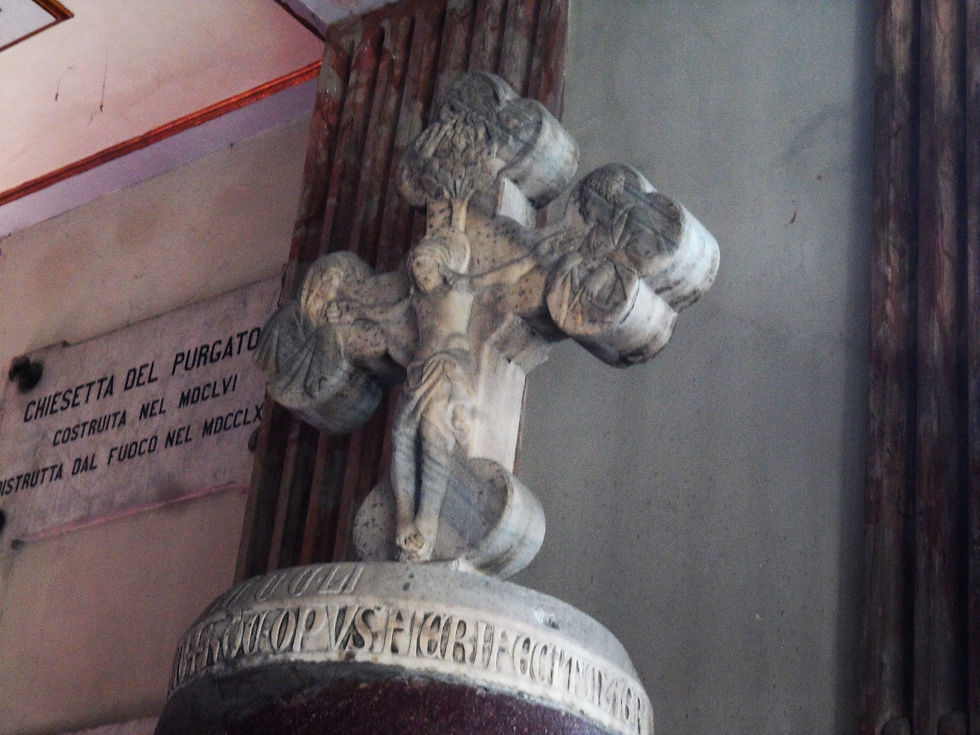Naples: between Corradino and Masaniello
- Angelo e Adele
- Jan 3, 2020
- 4 min read
Updated: Dec 29, 2022
First edition: 13 December 2017 An update to this post from two years ago: the restoration work on the bell tower of the Basilica del Carmine has been completed and we show you the result:

Below is the original text of the post: This time we make a foray into the history of the Kingdom of Naples, visiting a square where some particularly dramatic events took place, one of which was the beginning of the revolt led by Masaniello in 1647. We are talking about Piazza Mercato: on the square and on the monuments hosted in it you can easily find on the net and on the guides all the historical and artistic information you want. A first tip is to get there by car. There are in fact some places reserved for the disabled in the nearby Piazza del Carmine; the alternative is to get off the metro at GARIBALDI and from there take the entire Corso Garibaldi to Via Marina, passing on a sidewalk that is not really comfortable. Let's start by taking an overall look at the square:

We immediately see the beautiful and the less beautiful of this square as it is today: on the left you can see the Church of Santa Croce and Purgatorio al Mercato, on the right the Basilica Sanctuary of Santa Maria del Carmine Maggiore, with its 75 meter high bell tower, today under restoration and covered with scaffolding; to counterbalance the two monuments there is the ugliness of the modern buildings, starting with that Palazzo Ottieri, to the right of the basilica, built in the 50s of the last century, which with its size removes air and light from the square, as well as the view of the sea. Then we begin the visit from the most significant and rich in history monument, the Basilica Sanctuary of Santa Maria del Carmine Maggiore, or Basilica del Carmine (www.santuariocarminemaggiore.it). Erected in the thirteenth century, the facade is affected by the signs of time, but as soon as you enter you can perceive a splendor and a baroque splendor that testify to the historical importance of this basilica.


The statue on the left is that of the funeral monument of Corradino of Swabia, the first of those executed in Piazza Mercato (1268), a sequence that ended in 1800 with the execution of the patriots of the Neapolitan Republic and in particular of Luisa Sanfelice. But let's take a look at some details of the basilica:





To the right of the entrance to the basilica you enter the Cloister of the Carmine, also under restoration but of which we can exhibit some photos taken during the opening to the public on the F.A.I. day of October 15:



We now enter the actual Piazza Mercato: the Church of Santa Croce and Purgatorio al Mercato immediately strikes us, formed by the union of two small pre-existing churches destroyed in the fire of 1781; this church is also being restored and we can show the photos taken inside during the day of the F.A.I .:




But Piazza Mercato was also full of fountains, some destroyed, others moved elsewhere; only the two eighteenth-century Fountains of Seguro remain, identical to each other and recently the subject of careful restoration:



At the end of the square we find another important church, Sant'Eligio Maggiore, built in 1270 by the Angevins. The church is accessible by wheelchair from a secondary entrance on Piazza Mercato; an accompanying person must go inside the church to ask for it to be opened. Let's start with some external shots that restore the Gothic grandeur:



Here are some photos of the interior:



To leave Piazza Mercato you have to pass under the Arco di Sant'Eligio, a fifteenth-century building that joins the church tower to an adjacent building (someone will have noticed it in the fiction I bastardi di Pizzofalcone); on the first floor of the arch there is a clock under the frame of which two heads are represented that would refer to a sixteenth-century legend, also narrated by Benedetto Croce, a story of love, bullying, blackmail and final decapitation of the villain, which is easy to trace on the Internet.


Leaving Piazza Mercato we can walk a few meters to see the entrance to the fourteenth-century church of San Giovanni a Mare, also inaccessible; from the top of the staircase leading to the church you can see the copy of the so-called Donna Marianna 'a capa' e Napule, a statue from the Greek era found near Piazza Mercato, the original of which is today in the atrium of Palazzo San Giacomo, seat of the Municipality of Naples:

If you have followed our advice to come by car, at this point you can return to Piazza del Carmine, take your car back and reach in a few kilometers a place we have already talked about, where you can park comfortably, have lunch with different restaurant options and pizzerias and shopping for typical food products of Campania: Eccellenze Campane (*): Via Benedetto Brin 69, Naples +39 081 5636303 https://www.veracesudd.it/it/ Otherwise, exiting from Piazza del Carmine and turning right, you can walk about 1 km along Via Nuova Marina to get to a restaurant with similar characteristics to Eccellenze Campane:
Grangusto (*): Via Nuova Marina 5, Naples +39 081 19376832 https://www.facebook.com/grangusto.napoli/ (*) symbol indicating the presence of toilets equipped for the disabled

Comments